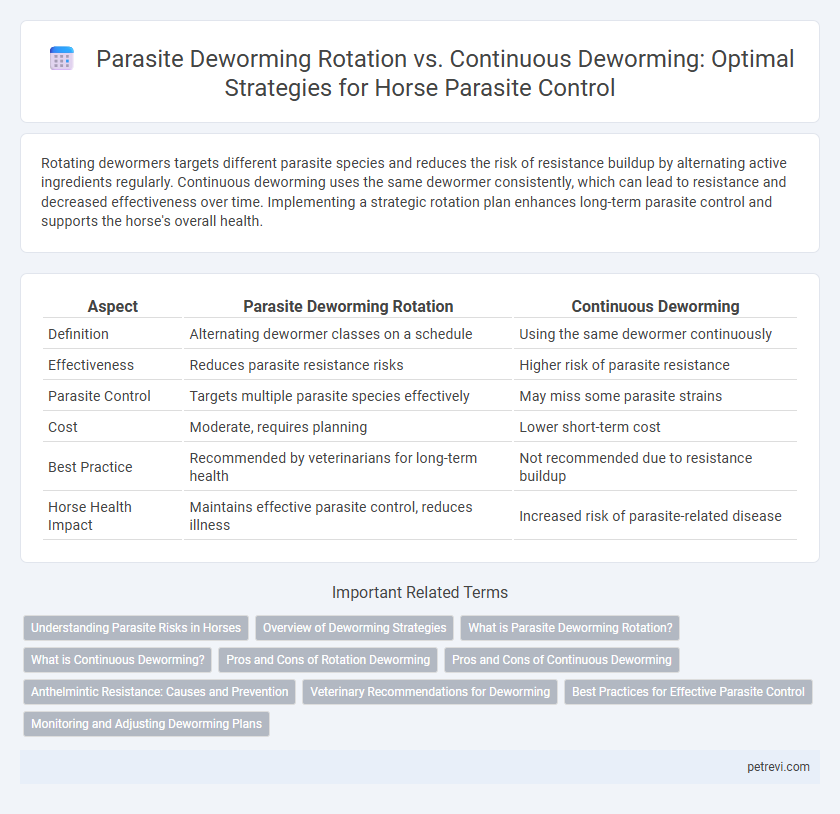Rotating dewormers targets different parasite species and reduces the risk of resistance buildup by alternating active ingredients regularly. Continuous deworming uses the same dewormer consistently, which can lead to resistance and decreased effectiveness over time. Implementing a strategic rotation plan enhances long-term parasite control and supports the horse's overall health.
Table of Comparison
| Aspect | Parasite Deworming Rotation | Continuous Deworming |
|---|---|---|
| Definition | Alternating dewormer classes on a schedule | Using the same dewormer continuously |
| Effectiveness | Reduces parasite resistance risks | Higher risk of parasite resistance |
| Parasite Control | Targets multiple parasite species effectively | May miss some parasite strains |
| Cost | Moderate, requires planning | Lower short-term cost |
| Best Practice | Recommended by veterinarians for long-term health | Not recommended due to resistance buildup |
| Horse Health Impact | Maintains effective parasite control, reduces illness | Increased risk of parasite-related disease |
Understanding Parasite Risks in Horses
Understanding parasite risks in horses is crucial for effective parasite control. Parasite deworming rotation involves alternating between different classes of dewormers to reduce resistance development, while continuous deworming uses the same product repeatedly, risking parasite resistance. Monitoring fecal egg counts and recognizing parasites like strongyles and bots helps tailor deworming strategies to protect equine health and optimize parasite management.
Overview of Deworming Strategies
Parasite deworming rotation involves alternating between different classes of anthelmintics to reduce drug resistance in horse parasites. Continuous deworming uses a consistent dewormer regularly, aimed at maintaining low parasite loads but risks selecting resistant parasite populations. Effective parasite control combines strategic rotation with fecal egg count monitoring to optimize treatment timing and minimize resistance development.
What is Parasite Deworming Rotation?
Parasite deworming rotation involves alternating different classes of anthelmintics on a scheduled basis to reduce resistance development in horse parasites. This strategy targets various parasite species effectively by using multiple active ingredients in a systematic sequence. Regular rotation helps maintain drug efficacy and supports long-term parasite control in equine populations.
What is Continuous Deworming?
Continuous deworming for horses involves administering anthelmintic treatments at regular, frequent intervals throughout the year to consistently control parasite loads. This method aims to reduce parasite exposure and prevent the buildup of resistant worm populations by avoiding prolonged gaps between treatments. Continuous deworming contrasts with rotation strategies by maintaining a steady approach rather than alternating medications or treatment schedules.
Pros and Cons of Rotation Deworming
Rotation deworming for horse parasite control involves alternating anthelmintic classes to reduce parasite resistance and maintain drug efficacy. Pros include slowing resistance development and targeting multiple parasite species, but cons involve risks of incorrect rotation schedules leading to ineffective treatments and increased costs. Consistent monitoring and fecal egg count tests are essential to optimize rotation benefits and prevent overuse of specific dewormers.
Pros and Cons of Continuous Deworming
Continuous deworming in horses offers consistent parasite control by maintaining steady anthelmintic levels, reducing the risk of heavy worm burdens and associated health issues like colic and weight loss. However, this approach increases the likelihood of anthelmintic resistance, as repeated exposure to the same dewormers allows parasites to adapt and survive treatment. It also may lead to unnecessary medication, disrupting the natural parasite ecosystem and potentially affecting the horse's immunity.
Anthelmintic Resistance: Causes and Prevention
Effective parasite control in horses requires careful management of anthelmintic resistance, a growing concern caused by frequent and improper use of dewormers. Parasite deworming rotation, which involves cycling through different classes of anthelmintics, helps delay resistance by reducing selective pressure on parasite populations. Continuous deworming with a single drug class accelerates resistance development, making integrated strategies like fecal egg count monitoring and targeted treatments essential for sustainable horse health.
Veterinary Recommendations for Deworming
Veterinary recommendations for horse parasite control emphasize rotational deworming based on fecal egg count results to reduce the risk of anthelmintic resistance. Continuous deworming schedules often lead to drug resistance, making targeted treatments more effective in managing strongyles, tapeworms, and bots. Parasite control protocols should be tailored to individual horses and pasture management factors to optimize health outcomes.
Best Practices for Effective Parasite Control
Effective parasite control in horses relies on strategic deworming practices, with rotation and continuous methods offering distinct benefits. Rotational deworming, involving alternating classes of anthelmintics such as ivermectin, fenbendazole, and pyrantel, helps prevent the development of parasite resistance by targeting different parasite life stages. Continuous deworming, typically using a single class of dewormer regularly, can maintain low parasite burdens but risks promoting resistance; best practices emphasize fecal egg count monitoring to tailor treatments for optimal efficacy.
Monitoring and Adjusting Deworming Plans
Effective horse parasite control requires regular monitoring through fecal egg count tests to guide deworming frequency and selection. Deworming rotation helps prevent parasite resistance by alternating active ingredients, while continuous deworming may lead to drug resistance without tailored adjustments. Adjusting deworming plans based on parasite load and environmental factors ensures optimal health and minimizes resistance development.
Parasite Deworming Rotation vs Continuous for Horse Parasite Control Infographic

 petrevi.com
petrevi.com